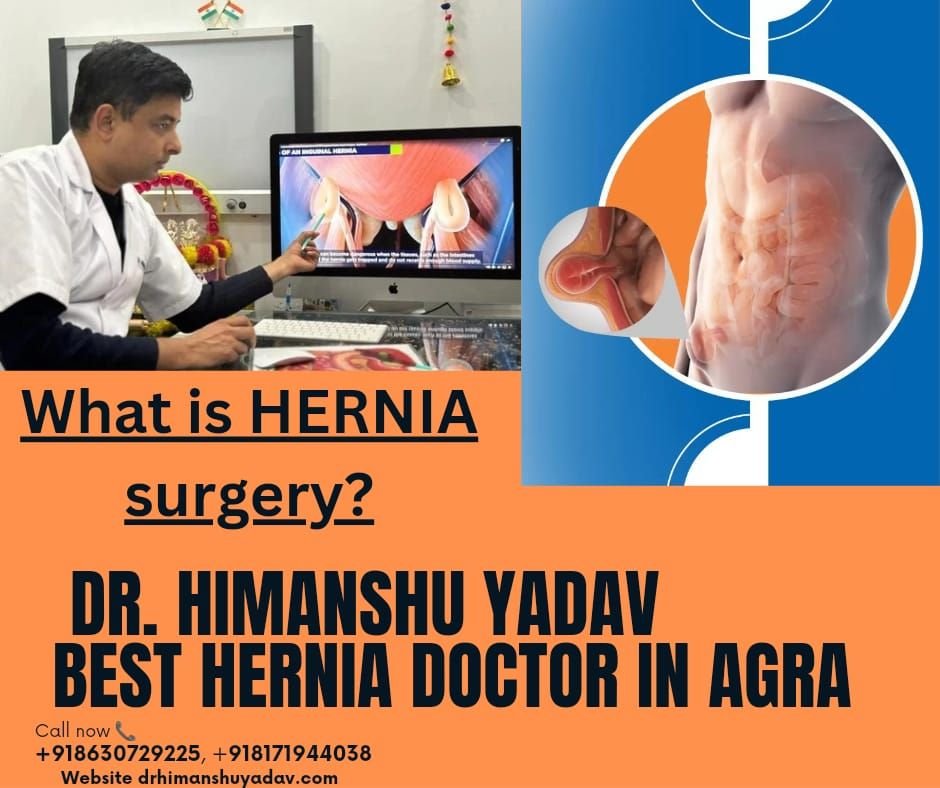
Hernia Treatment: Expert Guidance from Dr. Himanshu Yadav
Are you suffering from a hernia? Don’t let it control your life. Dr. Himanshu Yadav, a renowned hernia surgeon with years of experience, is here to provide expert guidance and effective treatment.
What is a Hernia?
A hernia occurs when part of an organ, typically the intestine, pushes through a weak spot in the abdominal wall. This can cause pain, discomfort, and in some cases, complications.
Types of Hernias: primarily 3 most common types are
- Inguinal Hernia: The most common type, occurring in the groin.
- Umbilical Hernia: Found around the belly button.
- Hiatal Hernia: Occurs when part of the stomach protrudes into the chest.
- Other hernias can be seen in diagram below

Symptoms of a Hernia:
Common Symptoms of a Hernia:
- A Bulge: One of the most noticeable symptoms of a hernia is a visible bulge in the affected area. This bulge may become more prominent when you strain, cough, or lift heavy objects.
- Pain or Discomfort: A hernia can cause pain or discomfort in the area where it occurs. The pain may be described as a dull ache, a sharp pain, or a burning sensation.
- Tenderness: The area around the hernia may be tender to the touch.
- Nausea and Vomiting: In some cases, a hernia can lead to nausea and vomiting, especially if the intestine becomes trapped or obstructed.
- Difficulty Urinating or Defecating: If the hernia affects the urinary tract or intestines, it can cause difficulty urinating or defecating
When to See a Doctor:
If you experience any of the above symptoms, it’s important to consult with a healthcare professional. Early diagnosis and treatment can prevent complications. For detailed information kindly refer to https://drhimanshuyadav.com/hernia-surgery/ .
Hernia Treatment Options:
Dr. Himanshu Yadav offers a range of treatment options tailored to your specific needs, including:
- Observation: For small hernias that may not require immediate surgery.
- Surgery: The most common treatment for hernias, which can be performed using traditional open techniques or minimally invasive laparoscopic surgery. Traditional Open Surgery for Hernias – In traditional open hernia surgery, the surgeon makes a larger incision in the abdomen to access and repair the hernia. This method is typically used for complex hernias or when other surgeries are being performed simultaneously. Although more invasive, open surgery is a proven option for certain patients. Minimally Invasive Hernia Surgery Techniques – Minimally invasive hernia surgery, also known as laparoscopic hernia repair, involves smaller incisions, often using a laparoscope—a thin tube with a camera attached. This method offers several advantages over traditional open surgery, including:
- Smaller incisions: Results in minimal scarring and faster recovery.
- Reduced pain: Less post-surgical discomfort.
- Shorter hospital stay: Many patients are discharged the same day or the following day. Advanced Minimally Invasive Hernia Repair Techniques – There are several advanced minimally invasive techniques for hernia surgery, such as:
- eTEPP (Enhanced Totally Extraperitoneal Patch Repair): Involves accessing the hernia through a small groin incision.
- TAPP (Transabdominal Preperitoneal Patch Repair): Uses a small abdominal incision to place a mesh patch behind the abdominal wall.
- Component Separation: Separates layers of the abdominal wall to create more space for hernia repair.
- SCOLA (Subcutaneous Component Separation and Laparoscopic Access): Combines component separation with laparoscopic techniques for enhanced repair.
- eMILOS (Enhanced Minimally Invasive Laparoscopic Onlay Mesh Repair): Involves placing a mesh over the hernia.
- rROM (Robot-Assisted Robotic Mesh Repair): Utilizes robotic technology to assist in the hernia repair procedure.
- TARM (Transabdominal Robotic Mesh Repair): Similar to rROM, this technique uses robotic assistance for precise hernia repair. Choosing the Best Hernia Surgery Method – Selecting the right hernia repair technique depends on several factors, such as the type of hernia, your overall health, and your surgeon’s expertise. Consult your doctor to determine the most appropriate technique for your hernia surgery.

Why Choose Dr. Himanshu Yadav?
- Extensive Experience: Dr. Yadav has a proven track record in diagnosing and treating hernias of all types.
- Advanced Techniques: He stays up-to-date with the latest advancements in hernia surgery, ensuring you receive the best possible care.
- Personalized Approach: Dr. Yadav takes the time to understand your unique situation and develop a treatment plan that meets your specific needs.
Book Your Consultation Today
Don’t let a hernia limit your quality of life. Contact Dr. Himanshu Yadav to schedule a consultation and discuss your treatment options. With his expert guidance and compassionate care, you can find relief and regain your comfort.
Lorem ipsum dolor sit amet, consectetur adipiscing elit. Ut elit tellus, luctus nec ullamcorper mattis, pulvinar dapibus leo.
